Getting students going on the Creative Process can take some thoughtful planning on the part of the teacher. Students are sometimes stuck for ideas and need someone to provide them with a catalyst for inspiration. The chart above is directly from the Ontario Curriculum for the Arts, and gives some great ideas for how to challenge and inspire student creations.
Recently, in my grade 3 and 4 art classes, I decided that I was going to try a new idea for inspiring creations and see how students responded to a new type of stimulus. I gave them some quotes about inclusion and equity to choose from, and their job was to create an art piece that represented what the quote meant to them. The tricky part was getting them going on their pieces and providing them with support and an environment that would produce the artwork that I knew that they were capable of.
Using the above chart as a guide, I followed the suggestions when trying to inspire my students creations:
Introduce the initial idea, challenge, stimulus, inspiration and experience
Introducing this art piece to my students was tricky. They really needed to get their brains turned onto the issues of equity and inclusion before we tried to analyze our quotes or come up with imagery for our art pieces. I started by reading them the story of Viola Desmond from the book “Viola Desmond Won’t Be Budged”. (The book is very easy to understand for all students, and Viola’s sister was in Toronto a couple of weeks ago, so the students had some familiarity with the story). 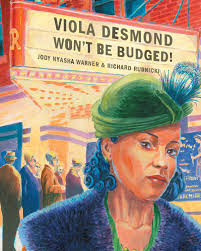 This got the students thinking about racial segregation and asking thoughtful questions about Viola’s experiences. I introduced the quotes to them and encouraged questions or collaboration with others to reflect on the meaning of the quote that they chose. I even had some students bring in their own quotes. I gave them a graphic organizer with some questions on it to help to get them started reflecting on their pieces. The completion of a graphic organizer also allowed me a chance to see who needed additional inspiration or support before they started their art.
This got the students thinking about racial segregation and asking thoughtful questions about Viola’s experiences. I introduced the quotes to them and encouraged questions or collaboration with others to reflect on the meaning of the quote that they chose. I even had some students bring in their own quotes. I gave them a graphic organizer with some questions on it to help to get them started reflecting on their pieces. The completion of a graphic organizer also allowed me a chance to see who needed additional inspiration or support before they started their art.
Provide models, examples and learning goals
As a class, we looked at the Peel District School Board art display for Black History Month on Twitter where many other students had used a variety of images to convey messages. We analyzed what we thought made particular pieces powerful and artistically appealing.
Establishes expectations, defines parameters and help develop criteria for success
Before we started our pieces, we talked through our criteria for successful completion of the art project. The students and I used Anne Davies process for co-creating a success criteria which can be found in the book “Setting and Using Criteria”.
The graphic organizer that I gave to students included the following questions:
My quote is:
In my own words, this means:
The symbols or images that this quote makes me think of are:
The mood I want to create in my art is:
The colours I will use are:
The focus of my piece (where I want people to look) is:
Some examples of the art with the quote that the students chose.
“Love is the only force capable of transforming an enemy into a friend.” – Martin Luther King Jr.
“I have decided to stick with love. Hate is too great a burden to bear”
– Martin Luther King Jr.
“It always seems impossible until it’s done.” – Nelson Mandela

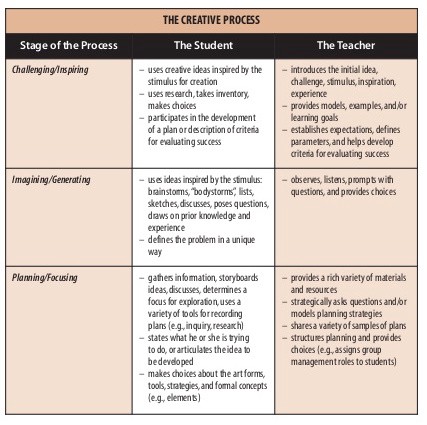
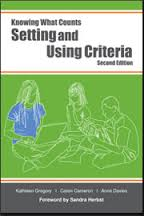
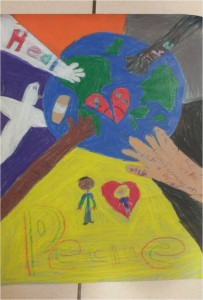
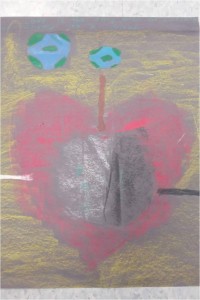
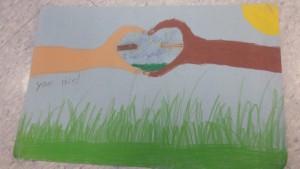
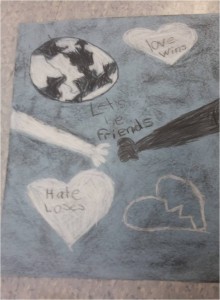
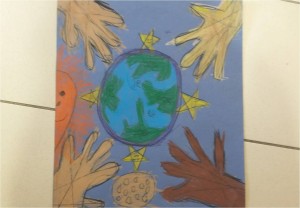
I just bought this Viola book for my Grade 3 & 4’s. Perhaps we can use the iPad to read quotes and study examples of inclusive art. Did you use pastels? What type of paper? Thank you.
Hi Ray,
We used woodless pencil crayons and construction paper for our creations.